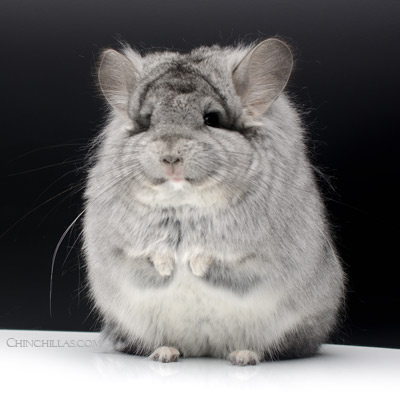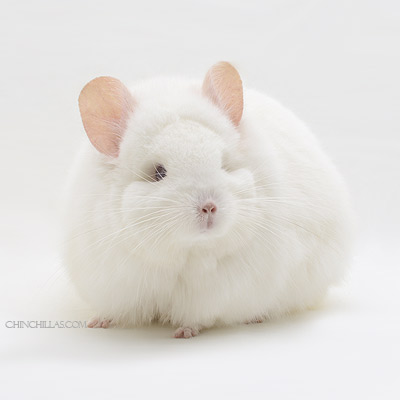The History of the Royal Persian Angora Chinchilla

(above) Pink White (violet carrier) G3 Royal Persian Angora Chinchilla
Royal Persian Angora chinchillas have added a new dimension to chinchilla breeding. Their notably long hair, along with a prepotency for universally desirable aesthetics, has drawn much attention from breeders and spectators around the world. The gene responsible for the long-furred mutation generally behaves like a true recessive, but not always. Most carriers have a phenotype similar to the agouti, but a few carriers have slightly longer hair than expected. In the homozygous form, the fur is truly that of long-furred type.
 This mutation was first observed in the early 1960's, as reported by Dr. J. Lauridsen. Fur producers of the era were interested in developing the mutation as an answer to fast production. The problem with the mutation in this market was that the fur was twice as long as that of a normal chinchilla, thus lacking the fur strength needed for a plush look. Additionally, the good clarity of color and dark color phase required by the fur industry proved difficult to produce in the new long-haired chinchillas.
This mutation was first observed in the early 1960's, as reported by Dr. J. Lauridsen. Fur producers of the era were interested in developing the mutation as an answer to fast production. The problem with the mutation in this market was that the fur was twice as long as that of a normal chinchilla, thus lacking the fur strength needed for a plush look. Additionally, the good clarity of color and dark color phase required by the fur industry proved difficult to produce in the new long-haired chinchillas.
One of the earliest appearances of the long haired mutation was in Fort Worth, Texas, observed by a Dr. Caraway.
Then in 1966, a breeder by the name of Roy Wilson began working with the long haired chinchilla when his ‘P4’ was born showing evidence of a long haired mutation. Whether or not this was the same mutation gene as those described earlier has not been determined. However, there is some phenotypic evidence to suggest that the same genetic mutation was involved in all three cases. The most prominent observable difference between Roy Wilson's chinchillas, and the long haired chinchillas described by Dr. Caraway and those of the Polish Canadian, was that Mr. Wilson's animals did not exhibit the off- color described in the other herds.
After several more years had passed, Mr. Wilson's friend Doyle Briscoe became half owner in Wilson's long haired herd. The Briscoes successfully showed long haired carriers, and had at least one Black Velvet long haired carrier that won Champion Black at a show in Texas. The fur of this particular carrier had a fairly normal, but slightly longer, plushy look.
 The long haired mutation was never a notable success for pelt production, but the gene was not lost. In April of 1997 another Texas breeder, in Amarillo, purchased the long haired chinchillas from the Briscoes, and spent several years propagating the mutation.
The long haired mutation was never a notable success for pelt production, but the gene was not lost. In April of 1997 another Texas breeder, in Amarillo, purchased the long haired chinchillas from the Briscoes, and spent several years propagating the mutation.
Starting in 2005, and continuing for the next 16 years, Chinchillas.com marketed, sold, and exported the Amarillo-bred long haired chinchillas, under the name 'Royal Persian Angoras' (abbreviated RPA, or rpa for carriers). The first of these exports left US shores bound for Russia, the Ukraine, France, and Belgium. 2007 saw the arrival of the Royal Persian Angoras in South Africa, Austria, Germany, and Hong Kong. In 2008, they made their way to Sweden, the Czech Republic, and Denmark. By 2010, the Chinchillas.com Royal Persian Angora exports arrived in Norway, Portugal, and China. In 2011, Finland and Japan also welcomed the arrival of this new mutation. And finally, in 2015, Chinchillas.com sold the Royal Persian Angoras closer to home - in the United States, and also in Canada.
By the summer of 2015, a number of Royal Persian Angoras listed on the Chinchillas.com Auction exhibited a progression in gene expression. Chinchillas.com coined the terms G2, and later G3 to recognize the distinction. These subjective terms simply mean Generation 2 and Generation 3. Beginning with 15252, a TOV Ebony Female, the G2 Royal Persian Angoras started to display ear tufts, lion manes, and/or longer fur. The G3 Royal Persian Angoras began to display even longer ear tufts and lion manes, or fur so long that it grew past ground level. Every Royal Persian Angora chinchilla is different. One might have notably long ear tufts, but not much of a lion mane. One might have no ear tufts, but fur that lays on the table.
By 2021, the Royal Persian Angoras had circumnavigated the globe. Breeders worldwide have added new hybrids, new qualities, and new dimensions to the long furred chinchillas.
Since the origin of the long haired mutation over 60 years ago, the long furred chinchilla has found its most successful place in the world among a global collective of hobbyist mutation chinchilla breeders.
Visit the Chinchillas.com Auction database to view hundreds of additional pictures of Royal Persian Angora chinchillas, or see new Royal Persian Angora chinchillas for sale in the Sales Gallery.